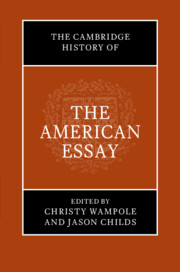Book contents
- The Cambridge History of the American Essay
- The Cambridge History of the American Essay
- Copyright page
- Contents
- Acknowledgments
- Notes on Contributors
- Introduction
- Part I The Emergence of the American Essay (1710–1865)
- Part II Voicing the American Experiment (1865–1945)
- 9 Writing Freedom before and after Emancipation
- 10 Social Justice and the American Essay
- 11 “Zones of Contention” in the Genteel Essay
- 12 The American Comic Essay
- 13 Nineteenth-Century American Travel Essays: Aesthetics, Modernity, and National Identity
- 14 American Pragmatism: An Essayistic Conception of Truth
- 15 The Essay in the Harlem Renaissance
- 16 The Southern Agrarians and the New Criticism
- 17 Subjective and Objective: Newspaper Columns
- 18 The Experience of Art: The Essay in Visual Culture
- 19 The Essay in American Music
- Part III Postwar Essays and Essayism (1945–2000)
- Part IV Toward the Contemporary American Essay (2000–2020)
- Recommendations for Further Reading
- Index
14 - American Pragmatism: An Essayistic Conception of Truth
from Part II - Voicing the American Experiment (1865–1945)
Published online by Cambridge University Press: 28 March 2024
- The Cambridge History of the American Essay
- The Cambridge History of the American Essay
- Copyright page
- Contents
- Acknowledgments
- Notes on Contributors
- Introduction
- Part I The Emergence of the American Essay (1710–1865)
- Part II Voicing the American Experiment (1865–1945)
- 9 Writing Freedom before and after Emancipation
- 10 Social Justice and the American Essay
- 11 “Zones of Contention” in the Genteel Essay
- 12 The American Comic Essay
- 13 Nineteenth-Century American Travel Essays: Aesthetics, Modernity, and National Identity
- 14 American Pragmatism: An Essayistic Conception of Truth
- 15 The Essay in the Harlem Renaissance
- 16 The Southern Agrarians and the New Criticism
- 17 Subjective and Objective: Newspaper Columns
- 18 The Experience of Art: The Essay in Visual Culture
- 19 The Essay in American Music
- Part III Postwar Essays and Essayism (1945–2000)
- Part IV Toward the Contemporary American Essay (2000–2020)
- Recommendations for Further Reading
- Index
Summary
This chapter centers on early American Pragmatist philosophers, such as Charles Sanders Peirce, William James, and John Dewey, and the abundance of essays they produced, outlining the fundamental tenets of pragmatism. From the beginning, the Pragmatists showed a special affinity for the essay. This genre of writing proved to be the perfect vehicle not simply to fashion and explore provisional truths but to drive home the case that truth is inherently provisional. James and other pragmatists saw thinking as a mode of action in the world, quite different from the standard dualism that separates “mind” from “matter.” Just as the noun essay calls to mind the verb form – to essay, attempt, or try – so pragmatism was for James less a philosophical position or ideology than a method or practice. For James and Dewey in particular, pragmatism helped explain how we use ideas and beliefs to achieve our aims and how we modify and adapt those ideas and beliefs as we test them in the contexts of our daily living and engagement with others. The chapter dwells on the most important pragmatist essays and shows the many ways these influenced later pragmatist-oriented philosophers, even up to today.
Keywords
- Type
- Chapter
- Information
- The Cambridge History of the American Essay , pp. 235 - 249Publisher: Cambridge University PressPrint publication year: 2023

